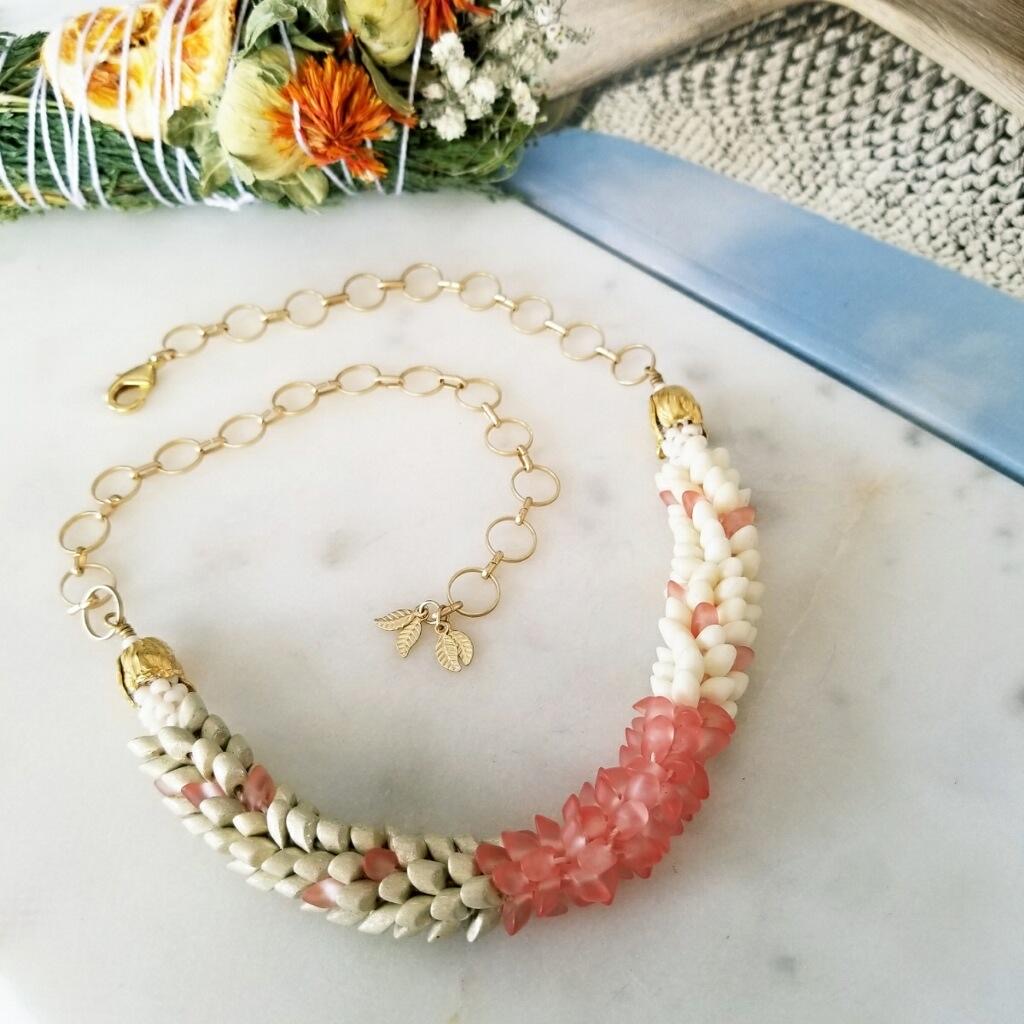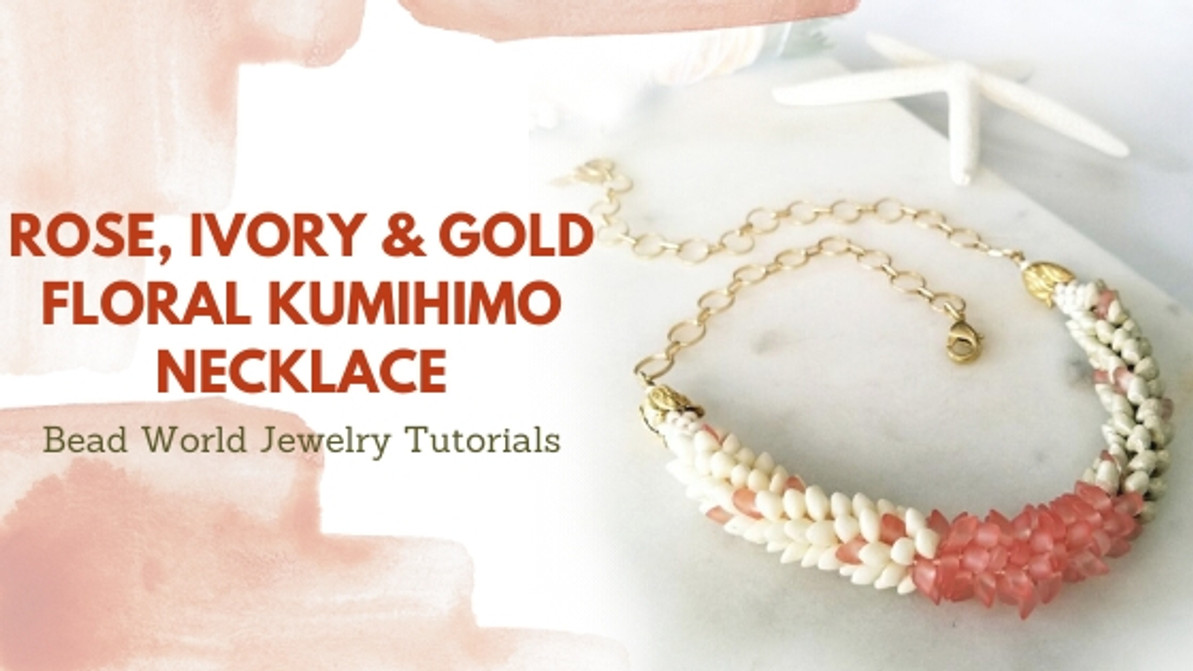Rose, Ivory & Gold Floral Kumihimo Necklace
Rose, Ivory & Gold Floral Kumihimo Necklace

Materials Needed:
- (20’) Macrame Cord, S-Lon Medium, Color – Natural (or whatever color works with your bead choice)
- 1 Tube of 4 x 7mm Magatamas – Cream Matte (70 used, approx. 85 per tube)
- 1 Tube of 4 x 7mm Magatamas – Galvanized Silver Matte (70 used, approx. 85 per tube)
- 1 Tube of 4 x7mm Magatamas – Transparent Rose Frosted (76 used, approx. 85 per tube)
- Size 8 Miyuki Seed Beads # 2021 Opaque Cream Matte
- 1’ Gold Chain (or Chain of your choice) *** 11” used in this necklace, if you need larger size add a few extra inches.
- Gold Plated 10x12mm Tulip End Caps (2)
- Gold Plate Trigger Clasp 15 x 9mm (1)
- 2” Long 22g Headpins Satin Hamilton Gold (1 used for dangle)
- 1” Section of Gold Plated Leaf Dangle Chain (or optional small charm to be used as end dangle)
Finished Length 16 -19” (this can be made to whatever length that you choose)
Tools Required
Round (or Mini) Kumihimo Braiding Disk
8 x Bobbins (for holding macramé cord)
Needle Nose Pliers (also known as chain nose)
Optional
Triangular Scoop (useful for scooping and moving piles of beads)
Instructions on Construction:
The colors in this necklace are elegant & refreshing…. but you could change it up & work with your favorite color palette. The central magatamas are strung randomly and the sections on either side point in two different directions, so that they point to the tulip end caps on either side which gave the piece a nice symmetry. You will need to take your time and have a lot of patience when stringing these beads because the effect is spoiled if the beads on either side are not ALL pointing in the same direction. I think you will agree the finished product is worth taking time over.
*** When making a kumihimo braid try to keep your weight centered in the hole & make sure that it is hanging because if it is resting on any surface it cannot act as a weight and your tension will start to look strange.
*** If you have to put your braid down & walk away remember to leave it with three strands in the bottom position, that way you will always know to start when you resume working on it.
*** Keep a tall tumbler handy, if you leave your work you can place the disk on top of the tumbler and everything stays neat.
*** Keep an eye on your work as you go that way you can correct any mistakes sooner than later. If you look at the braid and something looks strange (tension or missing bead maybe) you can reverse the flow of work and that will undo your braid, you can go back to the mistake and correct it. This means you will go from top left to bottom left, bottom right to top right and then turn ¼ turn clockwise and repeat. Give it a try, it works!
Take your bead matte and lay out your seed beads and magatamas into 4 separate piles, you don’t need to have them all out but it is good to have easy access when stringing.
1. Cut the 20’ of macramé cord into eight 30” lengths. Tie all eight macramé cord tails together using an overhand knot (like tying a balloon).
2. On first cord, string 4 size 8 seed beads, 10 galvanized silver matte magatamas (all pointing in the same direction with points going towards the seed beads – if in doubt hold cord up and make sure the beads all stack on top of each other), 7 rose magatamas (these need to be threaded in random directions so that they make a focal point in middle of necklace), 10 cream matte magatamas (all pointing in the same direction, but this time it will be opposite direction to the galvanized silver matte magatamas, so they will be pointing down towards the final seed beads), 4 size 8 seed beads and then tie a double knot at the end of the strand to act as a stopper. Wind this beaded section onto your number 1 bobbin. Repeat this with six of the other seven cords.
*** I find it useful to number the bobbins I use a sharpie and number them 1-8
3. On cord # 8 string 4 size 8 seed beads, 10 rose magatamas (all pointing in the same direction, with points going towards the seed beads – the same direction as the galvanized silver matte magatamas), 7 rose magatamas (these need to be threaded in random directions so that they make a focal point in middle of necklace), 10 rose magatamas (all pointing in the same direction, but this time it will be opposite direction to the galvanized silver matte magatamas, so they will be pointing down towards the final seed beads), 4 size 8 seed beads, tie the double knot at the end of strand to act as a stopper and wind these onto the # 8 bobbin.
4. Place the eight-strand knot into the hole in the center of the kumihimo disk and position the cords around the disk using the four dots as guides (one cord to each side of the dots). Slide # 1 bobbin cord into notch between 32 & 1 and work your way around clockwise from there ending with # 8 bobbin cord in the notch between 31 & 32, pull the cords tight and clip the weight to the knot hanging below the kumihimo disk.
5. Begin kumihimo by moving the cord at the top right (between 32 & 1) to the bottom right (between 14 & 15). Move the cord at bottom left (between 16 & 17) to the top left (between 30 & 31). Pull cord tight into notch as this will keep a good tension.
6. Rotate the entire kumihimo disk counterclockwise ¼ turn. Move the cord at the top right (between 8 & 9) to the bottom right (between 22 & 23), move the cord at the bottom left (between 24 & 25) to the top left (between 6 & 7). Repeat until you have about 1/4 – 1/2” of a kumihimo braid.
7. Now the fun begins & it’s time to add beads. You will be repeating the previous instructions but this time when you move the cord from the notch, slide one bead from that cord towards the center braid. You will slide the bead underneath the first cord that you cross over (this locks the bead into place) the cord will go to the same position that you have been doing.
*** It does help if your tension is tight, as it is easier to slide the bead under a taught strand). Remember to move cord from top right to bottom right, then bottom left to top left, rotate disk ¼ turn counterclockwise and repeat. The magatamas lock in the same way as the seed beads, you just have to make sure that the long pointy end is facing out.
8. Repeat step 7 adding a bead each time you move the cord until all beads are used. Repeat steps 5 and 6 creating a braid that is just cord (the same as beginning). Unclip the weight and gently remove all eight cords from the kumihimo disk. Tie the ends of the cord in an overhand knot, forming the knot over the initial braided section so that it sits right next to the seed beads. This bulks up the end so that it will fit nicely into tulip end cap.
9. Use a thread zapper to cut off excess cord but leaving the knot (which should ensure a good fit) melting the ends and securing the braid. Slide the end cap onto each end to determine how much more of the braid needs to be cut off for the end cap to reach the beads (you do not want to see any of the raw cord, so the end cap should meet flush with the seed beads). Trim off any extra length with the thread zapper. Repeat with other end of kumihimo braid.
10. Take one of the 2” headpins thread on one size 8 seed bead, thread through hole in the tulip end cap (from inside out) add one more size 8 seed bead and form wire wrapped loop, thread onto end section of chain, then complete wire wrap, this secures end cap to chain. Repeat with the second tulip end cap to the other end of chain. We will cut chain to correct length a little later on.
11. Place a small amount of E6000 glue on one kumihimo braid end (a toothpick is a handy tool to help with this). I also put a good amount of glue into the end cap to make sure that the braid is well attached inside the end cap. Slide the end cap onto the braid end. Clean up any extra glue as necessary (if you miss some glue it is possible to scrape off the end cap when dry). Repeat on the second end. E6000 takes a while to fully cure so be cautious while finishing the rest of the necklace, or if you can be really patient allow to cure for several hours before completing the next stage.
12. Measure the chain so that the clasp side has 9 circular links (approx. 4 ½”) and attach trigger clasp using the connector links in the chain (they do undo with a flat nose and needle nose pliers). The side with the dangle has 14 links (approx. 7”, this gives you a built in extension chain with pleasing drop that terminates with the Gold Plated Leaf Chain (I used a section with four leaves, but use what feels good
to you). If you need larger or smaller size add or decrease chain length here. Use your flat nose and needle nose pliers to remove links in chain & attach dangle.
13. Try on your new necklace & admire your handiwork!
14. Enjoy!
Jewelry designed by Steph Stirniman at magpiecollectives.com
Recent Posts
-
Dancing Pearl Cowboy Charm Leather Bracelet
Dancing Pearl Cowboy Charm Leather BraceletThis tutorial is a spin of our Dancing Gemstone Brac …17th Dec 2024 -
Christmas Wine Charms - Mini Tutorial
Christmas Wine Charms - Mini TutorialThese wine charms are sure to be the center talking point at yo …25th Nov 2024 -
Christmas Bow Garland - Mini Tutorial
Christmas Bow Garland - Mini TutorialCreate your own holiday decor with a Christmas-colored bow garl …14th Nov 2024




